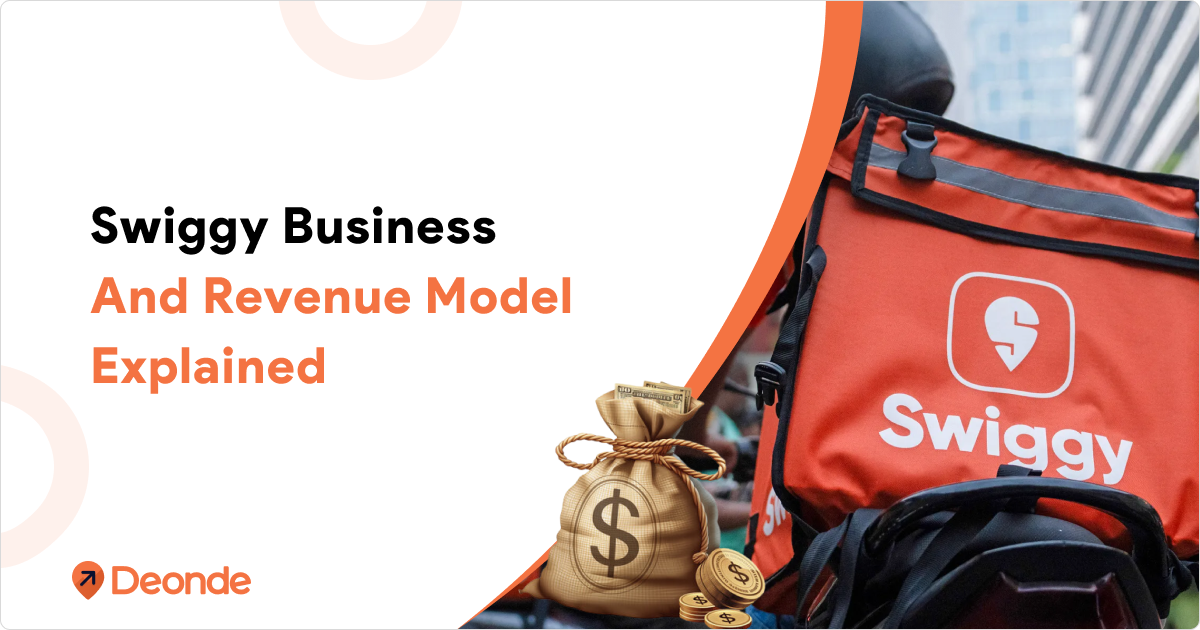Ever wondered how food delivery platforms like Just Eat generate billions without owning a single restaurant? You’re not alone. In today’s digital economy, the food delivery landscape has evolved into one of the most dynamic and competitive sectors globally.
Just Eat is among the most recognised names in online food ordering. Its business model matters because it exemplifies a scalable, technology-driven platform that connects millions of users with their favourite meals.
This blog will explore the Just Eat business model in depth. You’ll discover how Just Eat makes money, its revenue strategies, how it differs from competitors, and what makes its approach to food delivery so compelling.
By the end of this blog, you’ll understand how food delivery platforms operate and monetise, and why Just Eat remains a key player in this thriving industry.
What’s Just Eat?
Just Eat Takeaway.com is a leading global on-demand delivery company connecting 79 million customers with 756,000 partners, like restaurants, grocery, and retail stores, via its apps and websites. It operates in 18 countries, including Northern Europe, the UK, Ireland, Southern Europe, Australia, and North America.
Founded in 2000 in the Netherlands as Thuisbezorgd.nl by Jitse Groen, it grew through acquisitions and merged with Just Eat in 2020. Based in Amsterdam, it processed 879 million orders in 2024, with €26.3 billion in sales.
The platform links customers to local partners for easy ordering and delivery. Restaurants gain more customers, while couriers get flexible work. Just Eat blends a marketplace model with delivery in some areas.
Just Eat’s strong emphasis on technology, logistics, and scalability has allowed it to lead in the food delivery market. Its platform model forms the cornerstone of its revenue and growth strategy.

Understanding the Core: The Marketplace Model
Understanding that “one size doesn’t fit all” in logistics, Just Eat Takeaway.com employs two primary fulfilment models to get orders to consumers:
The Marketplace Model: Here, partners take the reins of delivery themselves. This model is ideal for establishments with their delivery fleets, allowing them to leverage the platform for order generation while maintaining control over the final mile.
The Delivery Model: This is where Just Eat Takeaway.com steps in with its expansive courier network. For partners who prefer to outsource logistics, or for markets where an integrated delivery service is crucial, JET’s couriers handle the delivery, ensuring a seamless experience from kitchen to customer.
This model creates a network effect: the more restaurants join the platform, the more attractive it becomes to users, and vice versa.
How Just Eat Takeaway.com Connects Consumers and Partners?

1. Search: It all begins with the consumer. You open the Just Eat app or website and search for your desired meal or grocery items from a vast selection of local partners. The platform offers unparalleled convenience, allowing easy browsing and choice.
2. Receive Order: Once you’ve selected and placed the order, the partner (restaurant, retailer, or grocer) receives it instantly through their interface on the Just Eat platform.
3. Prepare: The partner springs into action, preparing your order. For partners, Just Eat provides expanded reach and new customers, turning online visibility into sales.
4. Deliver: This is where the couriers come in. Depending on the fulfilment model, either the partner’s own delivery fleet (Marketplace Model) or Just Eat’s expansive courier network (Delivery Model) handles the last-mile delivery. Couriers are crucial for efficient and timely deliveries.
5. Enjoy: Finally, your order arrives, and you enjoy your meal or items. Just Eat aims to provide a seamless user experience and reliability, ensuring timely and accurate delivery.
Deep Dive into Just Eat Business Model

Beyond the deep dive into their core operations, understanding Just Eat Takeaway.com’s business model also requires identifying their foundational elements: who they work with, what they rely on, the specific value they offer, and who they serve.
Key Partners
Just Eat Takeaway.com’s ability to operate efficiently and scale globally relies heavily on a robust network of key external partners. These are the collaborators who enable the core business functions:
- Restaurants, Retailers, and Grocers: The most obvious and critical partners, providing the “supply”—the diverse range of food and goods consumers order. Their participation is fundamental to the platform’s offering and variety.
- Couriers (Independent Contractors & Third-Party Providers): While Just Eat Takeaway.com employs some couriers (Scoober), they heavily rely on a vast network of independent contractors and, to a lesser extent, external third-party logistics companies. These partners are essential for the last-mile delivery, especially in the delivery model.
- Payment Processors: Crucial for seamless and secure transactions, enabling smooth payment processes for consumers and partners.
- Technology & Infrastructure Providers: Like any large digital platform, they partner with cloud service providers, mapping services, and other technology vendors to ensure their apps and websites run reliably.
Key Resources
These are the most essential assets Just Eat Takeaway.com possesses and leverages to create and deliver its value proposition:
- Technology Platform (Apps & Websites): The digital backbone, including consumer apps, partner interfaces, courier management systems, and underlying data infrastructure.
- Extensive Partner Network: The sheer number and diversity of restaurants, retailers, and grocery stores on their platform serve as a massive asset and competitive advantage.
- Large Courier Network: A critical operational resource, enabling efficient and timely deliveries.
- Brand Recognition & Trust: The “Just Eat Takeaway.com” brand and its local iterations carry significant recognition and trust.
- Data & Analytics: Vast data on preferences, order patterns, and efficiency inform strategy and optimise operations.
- Human Capital: Skilled employees in technology, marketing, operations, sales, and customer service.
- Financial Capital: Significant investment capacity for growth, technology, marketing, and acquisitions.
Value Proposition
Just Eat Takeaway.com offers distinct value propositions tailored to its different customer segments:
- For Consumers:
- Unparalleled Convenience: Easy ordering, payment, and tracking for food, groceries, and retail items.
- Vast Choice & Variety: Access to a broad and diverse selection of restaurants and stores.
- Seamless User Experience: User-friendly interface and transparent order tracking.
- Reliability: The promise of timely and accurate delivery or collection.
- For Partners (Restaurants, Retailers, Grocers):
- Expanded Reach & New Customers: Access to a massive online customer base.
- Enhanced Visibility & Marketing: Increased exposure and an additional sales channel.
- Operational Efficiency (for Delivery Model): Outsourcing delivery reduces overheads.
- Business Growth: A reliable platform to grow sales.
- For Couriers (Especially ‘Scoober’ Employed Couriers):
- Stability & Benefits: Health & safety training, social security, holiday pay, and sick leave.
- Flexibility & Earning Potential (for Independent Couriers): Ability to set hours and influence income.
Customer Segments
Just Eat Takeaway.com effectively serves three primary customer segments, each vital to its ecosystem:
- Consumers (Hungry Individuals & Households): The end-users place orders and value convenience, choice, and reliability.
- Partners (Restaurants, Retail & Grocery/Convenience Stores): Businesses listing products, seeking increased sales, broader reach, and efficient delivery.
- Couriers (Delivery Personnel): Individuals performing deliveries are attracted by income opportunities and, depending on the model, job stability or flexibility.
- Just Eat for Business (Corporate Customers): Companies and corporate clients who use Just Eat’s dedicated business service for workplace meal solutions. This includes ordering for team lunches, corporate events, or client meetings, offering a convenient way to cater to employees or guests with diverse menu options and streamlined payment processes.
Just Eat allows other businesses (like grocery stores) to use Just Eat’s logistics and courier network for customer orders, providing on-demand, same-day, and scheduled deliveries.
These segments fuel Just Eat’s ability to connect millions with convenient, varied dining options.
Just Eat Revenue Model: How Does Just Eat Make a Profit?

Commissions from Partners
Most of their revenue comes from commissions charged to partners, which are typically based on a percentage of the value of goods ordered through their platforms.
Other Services for Partners
To a lesser degree, they also generate revenue from value-added services such as payment processing and advertising opportunities for partners looking to boost their visibility further.
Consumer-Facing Fees
For orders where Just Eat Takeaway.com manages the delivery directly, they also levy service and delivery fees directly to consumers.
This hybrid model blends the aggregator and logistics provider approaches, similar to the Uber Eats revenue model.
Premium Listings/Advertising Fees
Restaurants can boost visibility on the platform through sponsored listings or premium placement. These paid marketing opportunities help restaurants stand out in competitive areas.
Advertising is an optional but powerful revenue stream, especially in urban markets with dense restaurant options.
Connection Fees (Initial/Onboarding Fees)
Just Eat sometimes charges a one-time onboarding or connection fee to new restaurants joining the platform. This fee covers setting up their digital presence, training, and integrating payment systems.
Though not a significant revenue stream, it helps offset customer acquisition and onboarding costs.
Transaction Fees
Just Eat may charge a small fee per transaction from customers or restaurants to process payments and maintain platform infrastructure.
These fees are generally embedded in business costs and contribute to platform upkeep.
Other Potential/Minor Streams
Other income sources include:
- Subscription models for restaurants seeking advanced analytics or CRM features.
- Data monetisation via insights sold to market research firms.
- Strategic partnerships or API access for POS systems and logistics partners.
These minor streams collectively add resilience to the company’s financial model.
Just Eat Marketing Strategy

Just Eat’s growth isn’t just about technology—its marketing strategy has played a critical role.
Performance Marketing
Just Eat invests heavily in search engine marketing (SEM) and social media ads to drive app installs and orders. Google Ads, Facebook, and Instagram are key acquisition channels.
By leveraging keyword research and data analytics, Just Eat targets high-intent users searching for food in real time.
Brand Campaigns
High-profile sponsorships—like sports team partnerships or celebrity endorsements—boost Just Eat’s visibility and brand trust. These efforts drive brand recognition and help differentiate it from competitors.
Notable campaigns like “Did Somebody Say Just Eat” with Snoop Dogg created cultural buzz and brand memorability.
Loyalty Programs
Just Eat offers the StampCards programme, each time you order, we’ll save up 10% of your order value towards a nice discount. When you’ve hit your 5th order, we’ll release your total saved up discount as a personal voucher. The voucher is valid for 3 months after the collection date and can only be redeemed at the specific restaurant you’ve ordered from.
Restaurant Acquisition
Just Eat’s restaurant acquisition teams work directly with eateries, using personalised pitches and onboarding support. This keeps the supply side strong and diverse, which is essential for customer satisfaction.
What are the Recent Developments and Innovations in Just Eat?
JET Go and Delivery-as-a-Service
Just Eat has fully rolled out its “JET Go” Delivery-as-a-Service platform in the UK with Co-op to extend logistics to grocery delivery, live in 15 other countries, including Canada, Australia, Bulgaria, and Spain.
Drone Delivery with Manna
Just Eat is taking food delivery to new heights by partnering with Manna, one of Europe’s largest drone delivery operators, to roll out drone-operated deliveries with over 165,000 successful deliveries to date.
Prosus Acquisition Offer
Prosus (AEX and JSE: PRX), a global technology company, officially launched its recommended all-cash offer for Just Eat Takeaway.com on May 20, 2025. This is a significant development, as it signifies Prosus’s intent to acquire 100% of JET’s shares.
Awards
- Just Eat Takeaway.com has granted incentive awards to eligible employees under its company incentive plans. (June 11, 2025)
- Just Eat’s Annual Awards Return! €50,000 in media value is up for grabs, helping to support their business in 2025
Conclusion: Why Just Eat Thrives
Just Eat’s marketplace model, diverse revenue streams, and innovative partnerships make it a leader in food delivery. With drone delivery and acquisitions on the horizon, its future looks bright.
Just Eat Takeaway.com (JET) had a steady Q1 2025, with flat GTV year-on-year (2% growth excluding Rest of World). The company reiterates its 2025 guidance, including plans to invest an additional €150 million for growth. Watch for a recommended offer from Prosus expected in Q2 2025.
Inspired by Just Eat’s success? Want to launch your food delivery platform like Just Eat? Deonde’s SaaS solutions can help you launch a food delivery app in a week.
Sources:
- Just Eat Takeaway.com Q1 2025 Trading Update
- Just Eat Takeaway.com Annual Report 2024
- Just Eat Takeaway.com Quarterly results
- Just Eat Takeaway.com News Room





